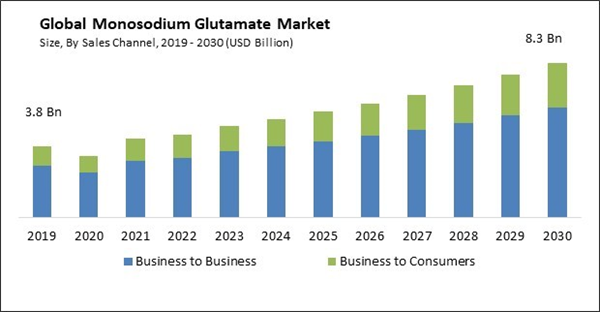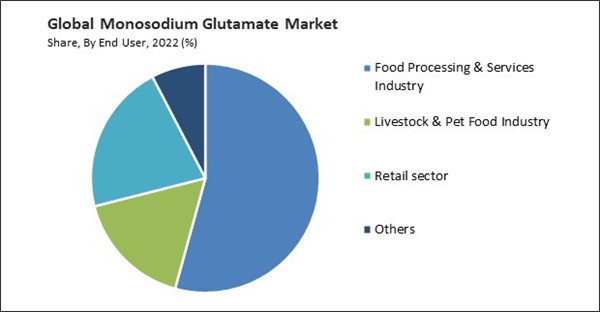The Global Monosodium Glutamate Market size is expected to reach $8.3 billion by 2030, rising at a market growth of 7.8% CAGR during the forecast period. In the year 2022, the market attained a volume of 3,540.5 Kilo Tonnes, experiencing a growth of 6.5% (2019-2022).
Consumers can purchase MSG from online retailers, including e-commerce platforms like Amazon, Walmart, and specialty food websites. Therefore, the online segment acquired $355.4 million revenue of the Business to Consumer segment in 2022. Online shopping offers a suitable way to order MSG. Some websites specialize in offering international and specialty food products. These may provide a variety of MSG options and related seasonings. Some manufacturers of MSG and seasoning products have websites where consumers can purchase their products directly. Some of the factors impacting the market are changes in lifestyle and food habits, rising expansion of food service industry, and health hazards of monosodium glutamate.
As people lead busier lives and seek convenient food options, the demand for processed and convenience foods has risen. Many of these products contain MSG as a flavor enhancer, making them more appealing. The globalization of food culture has increased appreciation for umami flavors and international cuisines. MSG is often used to enhance the savory taste of various world cuisines. MSG is an economical way to enhance the taste of food products. In emerging markets, where affordability is a significant consideration for consumers, MSG offers a cost-effective means of making dishes more flavorful. Additionally, Restaurants that offer a broad variety of international cuisines, from Thai and Indian to Mexican and Italian, have flourished. This demand for global flavors has driven the growth of specialty and ethnic restaurants, food trucks, and fusion cuisine concepts. The competitive nature of the food service industry can drive innovation in menu development. Chefs and culinary experts may experiment with different flavor profiles and ingredients, including MSG, to create unique and enticing dishes. This can stimulate the demand for specific MSG products tailored to these innovations. The expansion of the food service industry increases demand for market.
However, despite a lack of conclusive scientific evidence linking MSG to severe health hazards, there is a perception among some consumers that MSG is associated with health risks. This perception can discourage individuals from consuming MSG products and lead some food manufacturers to avoid using it. There are rare cases of individuals who claim to be allergic to MSG, experiencing more severe allergic reactions. Efforts by health organizations and the food industry to educate consumers about the safe use of MSG and to distinguish between perceived health risks and scientifically supported information can help mitigate challenges to the market. The health hazards associated with monosodium glutamate challenge the market growth.
The market research report covers the analysis of key stake holders of the market. Key companies profiled in the report include Meihua Holdings Group Co, Ltd, B & G Foods, Inc., R.M Chemicals Pvt. Ltd, Linghua Group Limited, Puramate India Pvt Ltd, Tate & Lyle PLC, Foodchem International Corporation, Ajinomoto Co., Inc., Cargill, Incorporated, and Kerry Group plc.
Consumers can purchase MSG from online retailers, including e-commerce platforms like Amazon, Walmart, and specialty food websites. Therefore, the online segment acquired $355.4 million revenue of the Business to Consumer segment in 2022. Online shopping offers a suitable way to order MSG. Some websites specialize in offering international and specialty food products. These may provide a variety of MSG options and related seasonings. Some manufacturers of MSG and seasoning products have websites where consumers can purchase their products directly. Some of the factors impacting the market are changes in lifestyle and food habits, rising expansion of food service industry, and health hazards of monosodium glutamate.
As people lead busier lives and seek convenient food options, the demand for processed and convenience foods has risen. Many of these products contain MSG as a flavor enhancer, making them more appealing. The globalization of food culture has increased appreciation for umami flavors and international cuisines. MSG is often used to enhance the savory taste of various world cuisines. MSG is an economical way to enhance the taste of food products. In emerging markets, where affordability is a significant consideration for consumers, MSG offers a cost-effective means of making dishes more flavorful. Additionally, Restaurants that offer a broad variety of international cuisines, from Thai and Indian to Mexican and Italian, have flourished. This demand for global flavors has driven the growth of specialty and ethnic restaurants, food trucks, and fusion cuisine concepts. The competitive nature of the food service industry can drive innovation in menu development. Chefs and culinary experts may experiment with different flavor profiles and ingredients, including MSG, to create unique and enticing dishes. This can stimulate the demand for specific MSG products tailored to these innovations. The expansion of the food service industry increases demand for market.
However, despite a lack of conclusive scientific evidence linking MSG to severe health hazards, there is a perception among some consumers that MSG is associated with health risks. This perception can discourage individuals from consuming MSG products and lead some food manufacturers to avoid using it. There are rare cases of individuals who claim to be allergic to MSG, experiencing more severe allergic reactions. Efforts by health organizations and the food industry to educate consumers about the safe use of MSG and to distinguish between perceived health risks and scientifically supported information can help mitigate challenges to the market. The health hazards associated with monosodium glutamate challenge the market growth.
End User Outlook
Based on end user, the market is segmented into food processing & services industry, livestock & pet food industry, retail sector, and others. In 2022, the food processing and services industry dominated the market with maximum revenue share. The increase in the global population's growth rate propels consumers' demand for food products in the market. Moreover, the hectic schedule of the consumers, lack of time for food preparation, and increased work pressure encourage consumers to look for healthy alternatives. The bakery products manufacturing companies are trying to improve the quality and nutritional offerings through food products to cater to the market demand. Additionally, the growing use of MSG to enhance diverse cuisines, expensive hotel food, and the rising trend of fast food are projected to support the growth of the market during the forecast period.Sales Channel Outlook
By sales channel, the market is fragmented into business to business and business to consumers. The business to consumers segment garnered a significant revenue share in the market in 2022. Most grocery stores and supermarkets carry MSG, usually found in the condiment or spice aisle. It is available in various packaging sizes, from small containers to larger bags. Some specialty food stores, particularly those that focus on Asian or international cuisine, may offer a variety of MSG brands and formulations. The business-to-consumer segment is expected to drive the expansion of the market due to the availability of food additives in retail packaging and the expanding use of flavor enhancers in-home meal preparation.Regional Outlook
Region-wise, the market is analyzed across North America, Europe, Asia Pacific, and LAMEA. In 2022, the Asia Pacific region witnessed the largest revenue share in the market. Asia-Pacific is the most lucrative region, owing to large-scale urbanization, increased foreign investment, and a surge in demand for processed food and beverages among millennials. This has been primarily attributed to changes in lifestyle and eating habits as well as increased purchasing power. From a production standpoint, the market is expanding significantly in Asia-Pacific. The bakery industry is rising fastest, boosting consumer demand for products, including frozen dough, breads, rolls, and other confectionery items. Another significant reason that has increased demand for many food additives, including MSG, is the growth of fast-food franchises and hotels. Therefore, the aforementioned reasons will influence the Asia-Pacific market growth during the forecast period.The market research report covers the analysis of key stake holders of the market. Key companies profiled in the report include Meihua Holdings Group Co, Ltd, B & G Foods, Inc., R.M Chemicals Pvt. Ltd, Linghua Group Limited, Puramate India Pvt Ltd, Tate & Lyle PLC, Foodchem International Corporation, Ajinomoto Co., Inc., Cargill, Incorporated, and Kerry Group plc.
Scope of the Study
Market Segments Covered in the Report:
By Sales Channel (Volume, Kilo Tonnes, USD Billion, 2019-2030)- Business to Business
- Business to Consumers
- Supermarket & Hypermarkets
- Convenience Stores
- Online Stores
- Others
- Food Processing & Services Industry
- Livestock & Pet Food Industry
- Retail sector
- Others
- North America
- US
- Canada
- Mexico
- Rest of North America- Europe
- Germany
- UK
- France
- Russia
- Spain
- Italy
- Rest of Europe- Asia Pacific
- China
- Japan
- India
- South Korea
- Singapore
- Malaysia
- Rest of Asia Pacific- LAMEA
- Brazil
- Argentina
- UAE
- Saudi Arabia
- South Africa
- Nigeria
- Rest of LAMEA
Key Market Players
List of Companies Profiled in the Report:
- Meihua Holdings Group Co, Ltd
- B & G Foods, Inc.
- R.M Chemicals Pvt. Ltd
- Linghua Group Limited
- Puramate India Pvt Ltd
- Tate & Lyle PLC
- Foodchem International Corporation
- Ajinomoto Co., Inc.
- Cargill, Incorporated
- Kerry Group plc
Table of Contents
Chapter 1. Market Scope & Methodology
Chapter 2. Market at a Glance
Chapter 3. Market Overview
Chapter 4. Global Monosodium Glutamate Market by Sales Channel
Chapter 5. Global Monosodium Glutamate Market by End User
Chapter 6. Global Monosodium Glutamate Market by Region
Chapter 7. Company Profiles
Companies Mentioned
- Meihua Holdings Group Co, Ltd
- B&G Foods, Inc.
- R.M Chemicals Pvt. Ltd
- Linghua Group Limited
- Puramate India Pvt Ltd
- Tate & Lyle PLC
- Foodchem International Corporation
- Ajinomoto Co., Inc.
- Cargill, Incorporated
- Kerry Group plc
Methodology

LOADING...










